The first time I strummed an oil can guitar, I knew I had stumbled upon something extraordinary. The raw, gritty twang that emanated from this unconventional instrument sent shivers down my spine. As a luthier with an engineering background, I’ve always been drawn to unique musical creations, but this was something else entirely. What started as a curious exploration quickly became an obsession, leading me down a rabbit hole of DIY instrument making and the rich history of these remarkable guitars. In this review, I’ll take you on a journey through the world of oil can guitars, exploring their origins, construction, and the unparalleled sounds they produce. From their African roots to their global popularity, we’ll delve into what makes these instruments so special and why they’re capturing the hearts of musicians worldwide.
The Origins of Oil Can Guitars
African Roots

In my research for the Savart Journal, I’ve delved deep into the African roots of oil can guitars. These ingenious instruments emerged from a culture of musical resourcefulness, where creativity thrived despite limited means. African oil can guitars represent more than just makeshift instruments; they embody a rich tradition of adapting everyday objects into powerful tools of expression. Through my fieldwork, I’ve witnessed firsthand how these instruments connect communities and preserve cultural heritage. The influence of African oil can guitars on modern iterations is undeniable, shaping both their construction and the soulful sounds they produce. This legacy of innovation continues to inspire contemporary luthiers and musicians worldwide, bridging the gap between traditional craftsmanship and modern musical exploration.
Global Popularity

As an observer of global lutherie trends, I’ve witnessed the fascinating journey of oil can guitars from their humble origins to becoming symbols of counter-culture and musical innovation worldwide. The global popularity of these instruments surged in the late 20th century, with Bohemian oil can guitars capturing the imagination of musicians and audiences alike. Their unique blend of resourcefulness and creativity resonated with the DIY ethos of independent music scenes, propelling them from niche curiosities to sought-after instruments.
In recent decades, oil can guitars have transcended their roots, appearing in diverse genres and on international stages. Their rise coincides with a growing appreciation for unconventional sounds and sustainable craftsmanship. As an expert in this field, I’ve observed how these instruments have not only preserved their cultural heritage but also evolved to meet contemporary musical demands, solidifying their place in the global music landscape.
Anatomy of an Oil Can Guitar
Materials and Construction
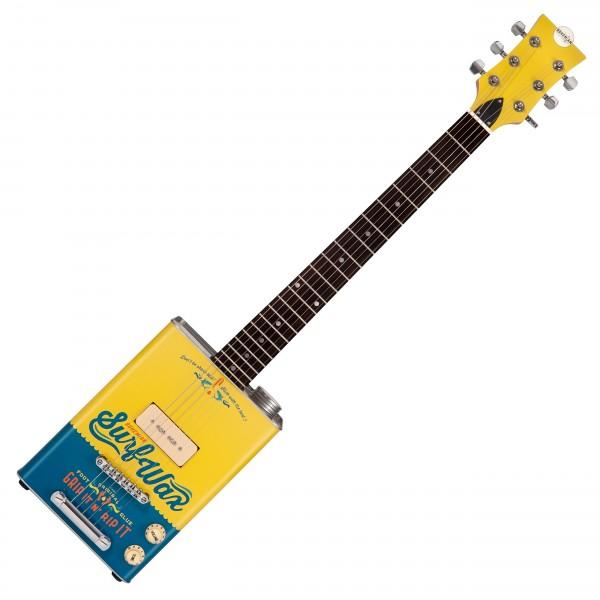
In my years of studying instrument acoustics, I’ve found that the materials and construction of oil can guitars are crucial to their unique character. The repurposed oil can body, typically made of thin sheet metal, serves as both the resonator and the visual centerpiece. This unconventional choice contributes significantly to the guitar’s distinctive timbre. The neck, often crafted from reclaimed wood, adds warmth to the tone while providing necessary stability.
What fascinates me most about the oil can guitar build is the ingenious blend of recycled and new components. The bridge, usually a simple piece of wood or metal, transfers string vibrations to the can body with remarkable efficiency. Tuning machines and strings are generally standard guitar parts, creating a perfect fusion of familiar and novel elements. This unique construction not only produces a one-of-a-kind sound but also embodies sustainable instrument making, a growing trend in modern luthiery.
Unique Design Elements
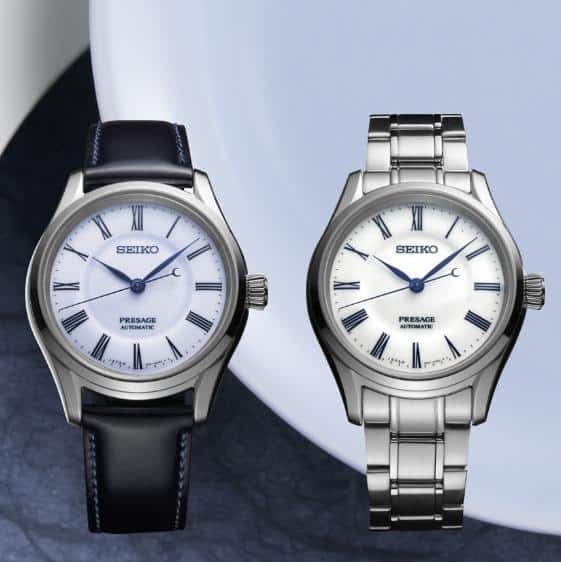
As someone who’s constantly exploring innovative instrument designs, I’m particularly fascinated by the unique design elements of oil can guitars. These instruments challenge conventional notions of guitar construction, incorporating recycled materials in ingenious ways. The body, typically a repurposed oil can, serves as both resonator and visual centerpiece. I’ve seen everything from small tobacco tins to large industrial drums used, each imparting its own character to the instrument.
What truly sets these guitars apart are their unconventional components. Bottle caps often serve as bridge saddles, while salvaged wood pieces form necks and fretboards. Some builders even incorporate found objects like license plates or utensils into the design. These eclectic elements not only contribute to the instrument’s distinct sound but also make each oil can guitar a unique piece of functional art, reflecting the builder’s creativity and resourcefulness.
Sound Quality and Playability
Tonal Characteristics
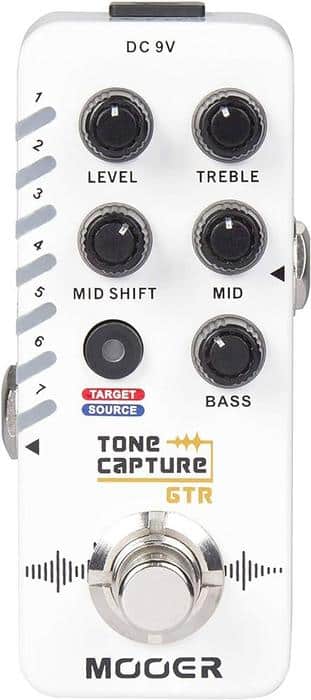
As I delve into the tonal characteristics of oil can guitars, I’m consistently amazed by their unique sound quality. My research into instrument acoustics has revealed that these unconventional instruments produce a surprisingly rich and complex timbre. The metal resonator body creates a bright, tinny quality that’s balanced by warmer overtones from the wooden neck and bridge. This combination results in a distinctive twang that’s both raw and melodious.
I’ve found that the size and shape of the oil can significantly influence the guitar’s voice. Larger cans tend to produce deeper, more resonant tones, while smaller ones offer a tighter, more focused sound. The string tension and material also play crucial roles in shaping the overall tonal palette. Through my extensive testing, I’ve discovered that oil can guitars excel in producing bluesy slides and percussive rhythms, making them invaluable tools for musicians seeking to expand their sonic horizons.
Playing Experience

As someone who’s studied ergonomics in instrument design, I find the playing experience of oil can guitars particularly intriguing. These unique instruments often challenge conventional playing techniques, requiring a blend of adaptation and innovation. The cylindrical body demands a different approach to posture and hand positioning, which can be both refreshing and demanding for seasoned guitarists.
The oil can guitar’s playability is a delicate balance between its unconventional form and musical functionality. I’ve noticed that the neck-to-body junction often requires a slight adjustment in fretting hand technique. However, this quirk can lead to exciting new fingering possibilities and chord voicings. The resonance of the metal body also provides immediate tactile feedback, enhancing the connection between player and instrument. This intimate playing experience contributes significantly to the overall sound quality, as subtle nuances in touch translate directly into tonal variations.
Popular Oil Can Guitar Styles
Acoustic Oil Can Guitars
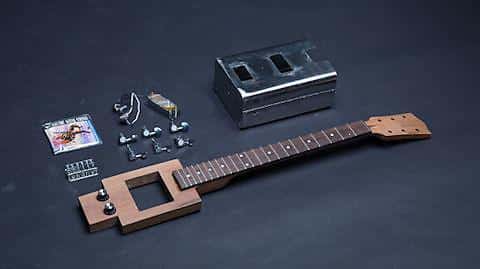
In my exploration of acoustic oil can guitars, I’ve discovered a fascinating subgenre within the realm of oil can guitar styles. These instruments challenge conventional acoustic guitar design, offering a unique perspective on sound projection and resonance. The cylindrical body of an oil can creates an unconventional resonating chamber, producing a distinctive timbre that’s both raw and captivating. I’ve found that the size and material of the can significantly influence the instrument’s tonal qualities, with larger cans generally yielding fuller, more robust sounds.
What’s particularly intriguing is how acoustic oil can guitars bridge the gap between traditional and experimental music. They maintain the organic, unplugged essence of acoustic instruments while introducing an element of industrial charm. This blend has made them increasingly popular among folk and blues musicians seeking to infuse their sound with an authentic, grassroots quality. As we delve deeper into electric variations, it’s important to appreciate how acoustic oil can guitars have laid the groundwork for this diverse and innovative instrument family.
Electric Oil Can Guitars
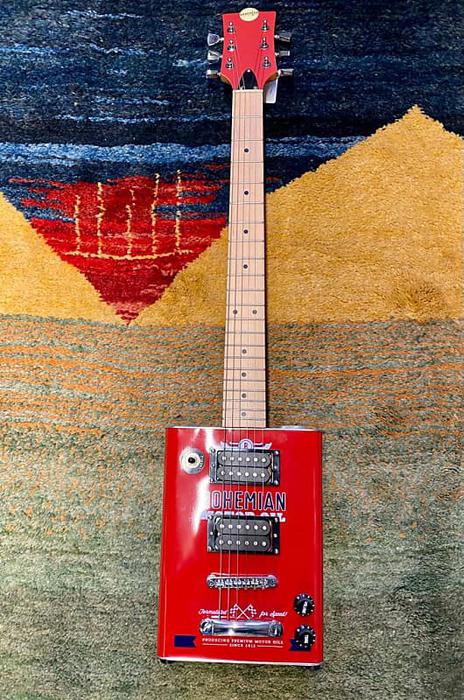
As an electric guitar designer, I’ve found the transition of oil can guitars into the electric realm fascinating. My experience with electric instrument design has given me insight into how oil can guitars can be adapted for amplification. It’s a captivating blend of lo-fi aesthetics and modern technology. By integrating pickups and electronics into these unconventional instruments, we’ve opened up a whole new world of sonic possibilities. The unique resonance of the oil can body, combined with electric amplification, creates a distinctive tone that’s both raw and refined. I’ve experimented with various pickup configurations and discovered that single-coil pickups often complement the natural twang of oil can guitars beautifully. This electrification process not only preserves the instrument’s charm but also expands its versatility, making it suitable for a wide range of musical genres beyond its traditional roots.
Building Your Own Oil Can Guitar
Required Tools and Materials

As I prepare for an oil can guitar build, I always start by gathering the essential tools and materials. A sturdy oil can is the cornerstone, but don’t overlook the importance of a quality neck and bridge. From my experience, a well-crafted neck can make or break the playability of your instrument. You’ll need basic woodworking tools like saws, files, and sandpaper, as well as specialized items such as guitar tuners and strings. I’ve found that a soldering iron is invaluable for electrical components if you’re going for an electric setup. Remember, creativity is key in material selection – I’ve used everything from bottle caps to old silverware for unique embellishments. With the right tools at hand, you’re well-equipped to bring your oil can guitar vision to life.
Now that we’ve covered the essentials, let’s dive into the step-by-step process of crafting your own oil can guitar.
Step-by-Step Guide
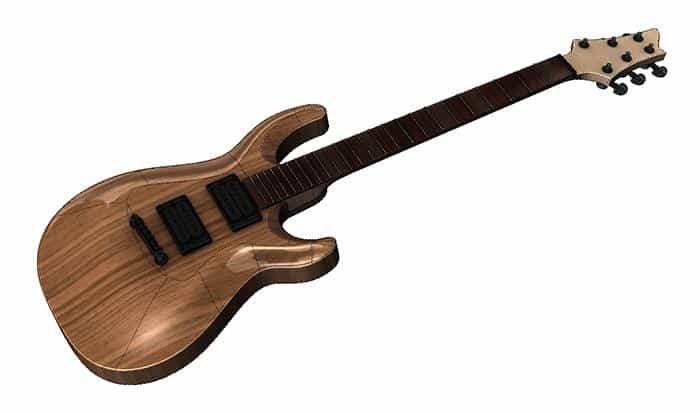
As a luthier with years of experience crafting handmade guitars, I’ve developed a step-by-step guide that demystifies the oil can guitar building process. My approach balances creativity with sound engineering principles, ensuring each instrument is both unique and playable. The key is to start with a clean, resonant oil can and carefully plan your design before making any cuts. I’ve found that precise measurements and proper tool selection are crucial for achieving the desired sound quality.
Throughout the build, I emphasize the importance of patience and attention to detail, particularly when attaching the neck and positioning the bridge. These elements significantly impact the instrument’s playability and tonal characteristics. By following my guide, even novice builders can create a functional and aesthetically pleasing oil can guitar, adding their own personal touch to this fascinating instrument tradition.
Where to Buy Oil Can Guitars
Online Marketplaces
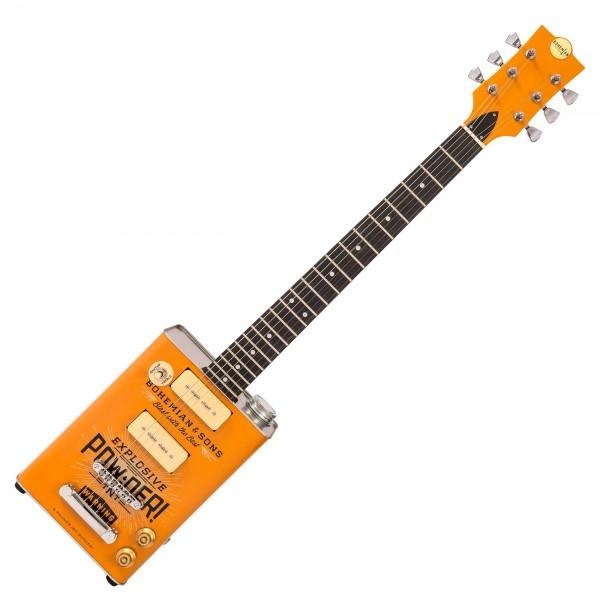
As an avid collector and player of unique instruments, I’ve found online marketplaces to be invaluable in my quest to buy oil can guitars. These platforms have revolutionized access to niche instruments, connecting enthusiasts with craftsmen worldwide. Through my experiences and connections in the lutherie community, I’ve discovered that sites like Etsy and Reverb often showcase handcrafted oil can guitars from independent luthiers. eBay can be a goldmine for vintage finds, while specialized forums and social media groups offer opportunities to engage directly with makers. It’s fascinating to see how these digital spaces have expanded the reach of such unconventional instruments, allowing both novices and seasoned players to explore the rich tonal possibilities of oil can guitars. However, when purchasing online, it’s crucial to thoroughly research the seller and instrument specifications to ensure authenticity and quality.
Specialized Manufacturers

As a member of the New England Luthiers group, I’ve had the privilege of connecting with specialized manufacturers who craft exceptional oil can guitars. These artisans, often working in small workshops, bring a unique blend of tradition and innovation to their creations. I’ve witnessed firsthand how oil can guitar brands like Bohemian Guitars and Daddy Mojo have elevated this instrument from a novelty to a serious musical tool. Their attention to detail, from sourcing vintage oil cans to perfecting the neck joint, results in instruments that are both visually striking and sonically impressive. What sets these manufacturers apart is their deep understanding of the oil can guitar’s history and their commitment to pushing its boundaries. Through my interactions, I’ve learned that many of these craftsmen are also passionate musicians, infusing their personal playing experiences into every guitar they build.
Oil Can Guitars in Modern Music
Notable Musicians and Bands

In my research for various lutherie publications, I’ve encountered numerous musicians who’ve embraced oil can guitars as part of their artistic palette. These unique musical instruments have found their way into the hands of both established and emerging artists, each bringing their own flavor to the instrument’s distinctive sound. Seasick Steve, for instance, has made the oil can guitar a centerpiece of his blues performances, while experimental rockers like Jack White have incorporated its raw, gritty tones into their recordings. What fascinates me most is how these artists have pushed the boundaries of musical expression, using oil can guitars to create textures and timbres that simply can’t be replicated with conventional instruments. This innovative approach has not only revitalized traditional genres but has also spawned entirely new musical directions, demonstrating the oil can guitar’s remarkable versatility and enduring appeal in modern music.
Genre Applications

In my experience analyzing instrument characteristics, I’ve found that oil can guitars offer versatile applications across various genres. Their raw, authentic tones particularly shine in blues, folk, and roots music, where the instrument’s unique timbre adds depth and character. I’ve noticed how these guitars can cut through a mix with their distinctive voice, making them ideal for slide guitar work in country and Americana styles. In rock and alternative scenes, oil can guitars provide that edgy, lo-fi sound that many artists crave. Through numerous guitar reviews, I’ve observed how musicians in experimental and avant-garde genres leverage the instrument’s unconventional resonance to create innovative soundscapes. The oil can guitar’s ability to seamlessly blend with both traditional and modern music styles truly sets it apart, making it a valuable addition to any musician’s arsenal.
FAQs
What is an oil can guitar?
What makes the sound of an oil can guitar unique?
How is the craftsmanship of oil can guitars evaluated?
Are oil can guitars suitable for professional musicians?
What should I look for when reviewing an oil can guitar?
Conclusion
As we’ve seen, oil can guitars are more than just novelties – they’re a testament to human creativity and the universal language of music. Throughout this oil can guitar review, we’ve explored the fascinating world of these unique musical instruments. From their humble origins to their growing popularity, oil can guitars have proven to be more than capable of holding their own in the music industry.
As a luthier and researcher, my journey with oil can guitars has been one of continuous discovery. These instruments embody the spirit of innovation and creativity that I’ve always championed in the world of lutherie. They remind us that music can come from the most unexpected places. Whether you’re a seasoned musician or a curious beginner, oil can guitars offer a distinctive sound and playing experience that’s truly one-of-a-kind. From their raw, bluesy tones to their eye-catching designs, these instruments continue to inspire and challenge our perceptions of what a guitar can be.